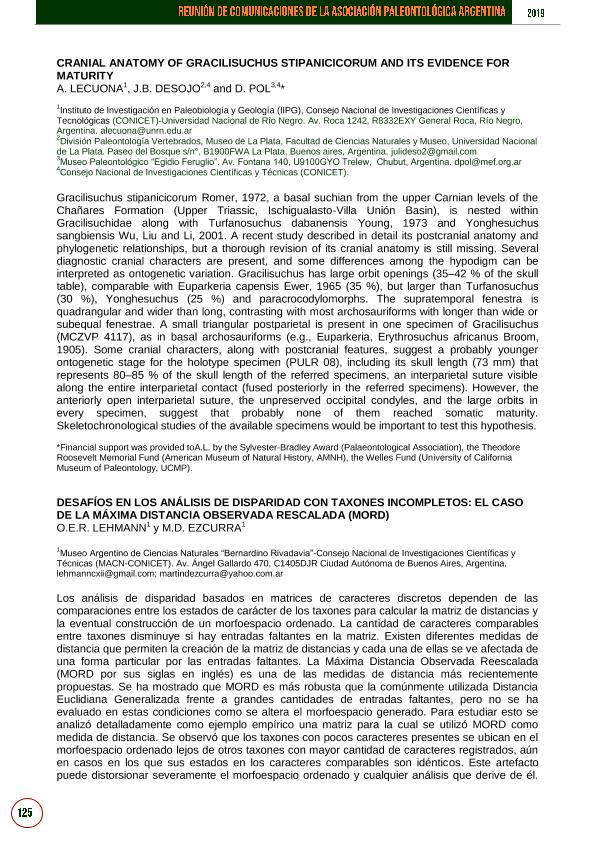Evento
Cranial anatomy of Gracilisuchus stipanicicorum and its evidence for maturity
Tipo del evento:
Reunión
Nombre del evento:
Reunión de Comunicaciones de la Asociación Paleontológica Argentina
Fecha del evento:
27/11/2019
Institución Organizadora:
Asociación Paleontológica Argentina;
Título del Libro:
Reunión de Comunicaciones de la Asociación Paleontológica Argentina 2019: Libro de resúmenes
Editorial:
Asociación Paleontológica Argentina
Idioma:
Inglés
Clasificación temática:
Resumen
Romer, 1972, a basal suchian from the upper Carnian levels of the Chañares Formation (Upper Triassic, Ischigualasto-Villa Unión Basin), is nested within Gracilisuchidae along with Turfanosuchus dabanensis Young, 1973 and Yonghesuchus sangbiensis Wu, Liu and Li, 2001. A recent study described in detail its postcranial anatomy and phylogenetic relationships, but a thorough revision of its cranial anatomy is still missing. Several diagnostic cranial characters are present, and some differences among the hypodigm can be interpreted as ontogenetic variation. Gracilisuchus has large orbit openings (35–42 % of the skull table), comparable with Euparkeria capensis Ewer, 1965 (35 %), but larger than Turfanosuchus (30 %), Yonghesuchus (25 %) and paracrocodylomorphs. The supratemporal fenestra is quadrangular and wider than long, contrasting with most archosauriforms with longer than wide or subequal fenestrae. A small triangular postparietal is present in one specimen of Gracilisuchus (MCZVP 4117), as in basal archosauriforms (e.g., Euparkeria, Erythrosuchus africanus Broom, 1905). Some cranial characters, along with postcranial features, suggest a probably younger ontogenetic stage for the holotype specimen (PULR 08), including its skull length (73 mm) that represents 80–85 % of the skull length of the referred specimens, an interparietal suture visible along the entire interparietal contact (fused posteriorly in the referred specimens). However, the anteriorly open interparietal suture, the unpreserved occipital condyles, and the large orbits in every specimen, suggest that probably none of them reached somatic maturity. Skeletochronological studies of the available specimens would be important to test this hypothesis.
Palabras clave:
GRACILISUCHUS
,
SKULL
,
ONTOGENY
Archivos asociados
Licencia
Identificadores
Colecciones
Eventos(IIPG)
Eventos de INSTITUTO DE INVESTIGACION EN PALEOBIOLOGIA Y GEOLOGIA
Eventos de INSTITUTO DE INVESTIGACION EN PALEOBIOLOGIA Y GEOLOGIA
Citación
Cranial anatomy of Gracilisuchus stipanicicorum and its evidence for maturity; Reunión de Comunicaciones de la Asociación Paleontológica Argentina; La Plata; Argentina; 2019; 125-125
Compartir




